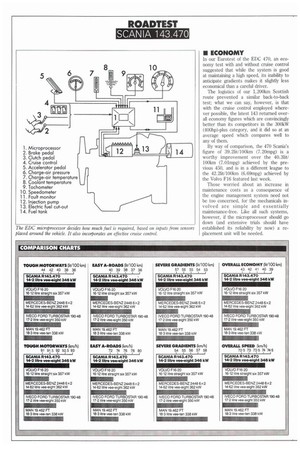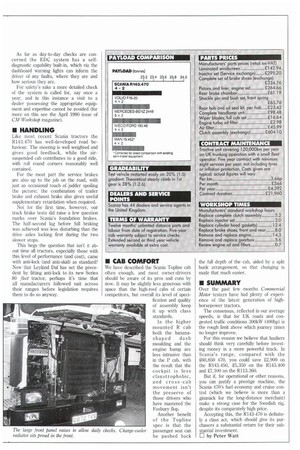• ECONOMY
Page 34

Page 35

If you've noticed an error in this article please click here to report it so we can fix it.
In our Eurotest of the EDC 470, an economy test with and without cruise control suggested that while the system is good at maintaining a high speed, its inability to anticipate gradients makes it slightly less economical than a careful driver.
The logistics of our 1,200krn Scottish route prevented a similar back-to-back test; what we can say, however, is that with the cruise control employed wherever possible, the latest 143 returned overall economy figures which are convincingly better than its competitors in the 300kW (400hp)-plus category, and it did so at an average speed which compares well to any of them.
By way of comparison, the 470 Scania's figure of 39.2lit/100km (7.20mpg) is a worthy improvement over the 40.3Iit/ 100km (7.01mpg) achieved by the previous 450, and is in a different league to the 42.2lit/100km (6.69mpg) achieved by the Volvo F16 featured last week.
Those worried about an increase in maintenance costs as a consequence of the engine management system need not be too concerned, for the mechanicals involved are simple and essentially maintenance-free. Like all such systems, however, if the microprocessor should go down (and extensive trials should have established its reliability by now) a replacement unit will be needed. As far as day-to-day checks are concerned the EDC system has a selfdiagnostic capability built-in, which via the dashboard warning lights can inform the driver of any faults, where they are and how serious they are.
For safety's sake a more detailed check of the system is called for, say once a year, and in this instance a visit to a dealer possessing the appropriate equipment and expertise cannot be avoided (for more on this see the April 1990 issue of CM Workshop magazine).
• HANDLING
Like most recent Scania tractors the R143.470 has well-developed road behaviour. The steering is well weighted and gives good feedback, while the airsuspended cab contributes to a good ride, with roll round corners reasonably well contained.
For the most part the service brakes are also up to the job on the road, with just an occasional touch of judder spoiling the picture; the combination of trailer brake and exhaust brake also gives useful supplementary retardation when required.
Not for the first time, however, our track brake tests did raise a few question marks over Scania's foundation brakes. The half-second lag before full braking was achieved was less disturbing than the drive axles locking first during the two slower stops.
This begs the question that isn't it about time all tractors, especially those with this level of performance (and cost), came with anti-lock (and anti-skid) as standard? Now that Leyland Daf has set the precedent by fitting anti-lock to its new Series 80 fleet tractor, perhaps it's time that all manufacturers followed suit across their ranges before legislation requires them to do so anyway.
• CAB COMFORT
We have described the Scania Topline cab often enough, and most owner-drivers should be aware of its pros and cons by now. IL may be slightly less generous with space than the high-roof cabs of certain competitors, but overall its level of speci fication and quality of assembly keep it up with class standards.
In the higher mounted R cab both the banana shaped dash moulding and the engine hump are less intrusive than in the P cab, with the result that the cockpit is less claustrophobic, and cross-cab movement isn't the preserve of those drivers who have mastered the Fosbury flop.
Another benefit of the Topline spec is that the checks. Charge-cooler passenger seat can be pushed back the full depth of the cab, aided by a split bunk arrangement, so that changing is made that much easier.
• SUMMARY
Over the past few months Commercial Motor testers have had plenty of experience of the latest generation of highhorsepower tractors.
The consensus, reflected in our average speeds, is that for UK roads and congested traffic conditions 300kW (400hp) is the rough limit above which journey times no longer improve.
For this reason we believe that hauliers should think very carefully before investing money in a more powerful truck. In Scania's range, compared with the 260,850 470, you could save 22,900 on the R143.450, 25,350 on the R143.400 and 27,100 on the R113.360.
But if, for operational or other reasons, you can justify a prestige machine, the Scania 470's fuel economy and cruise control (which we believe is more than a gimmick for the long-distance merchant) make a strong case for the Swedish rig, despite its comparately high price.
Accepting this, the R143-470 is definitely a class act, which should give its purchasers a substantial return for their substantial investment.
111 by Peter Watt
















































































































